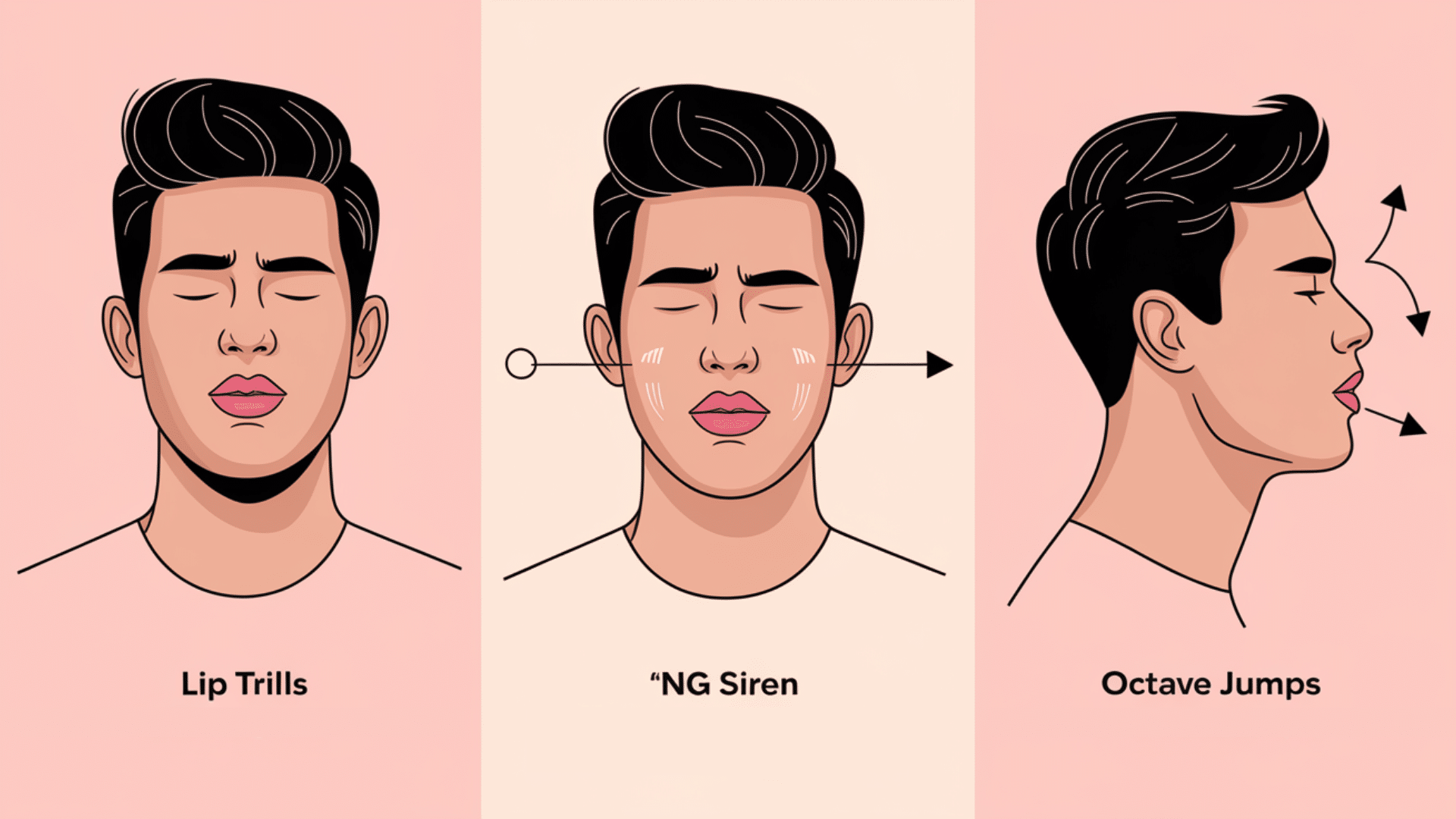Ever watched a male singer hit those sky-high notes and thought, “How on earth did he do that?” You’re not alone.
Many guys feel that singing high is like trying to reach the top shelf without a ladder – seemingly impossible without the right tools.
But here’s a little secret: those impressive high notes aren’t just for the naturally gifted. They’re skills you can learn, develop, and master.
In this guide, we’ll pull back the curtain on the techniques that professional singers use every day. No magic tricks – just practical methods that work for real guys with real voices.
Ready to surprise yourself (and maybe your audience) with notes you never thought possible? Let’s get started.
Techniques to Hit High Notes as a Guy
Singing high notes as a guy requires specific techniques that help your voice transition smoothly through different registers.
Take reference from this video of Ramsey Voice Studio about how to hit high notes. Here are key techniques to master:
Use Your Diaphragm, Not Your Throat
High notes require steady breath support from your diaphragm, not brute force. Engage your lower ribs and abs as if preparing to laugh for consistent airflow and less throat pressure.
Higher notes often require less airflow but more support. Consider support as managing the airflow: you release just enough to produce the sound without stressing your vocal cords.
Shape Your Vowels
Every vowel (like “ah”, “ee”, “oo”) has its own natural sound. As you go higher, slightly adjust your vowel shapes so they stay easy to sing. For example, very bright vowels like a wide “EE” might need to be relaxed toward an “IH” or “EH” sound on higher notes.
Keep vowels round and tall. Singers often widen their mouths on high notes. Instead, think of an “O” or “U” shape while singing “A”. Rounder vowels create a smoother sound path and help your voice ring without strain.
Rounder vowels create a smoother sound path and help your voice ring without strain—mastering this is part of what makes Singing Vowels essential for vocal excellence.
Use Forward Placement
Instead of thinking of pushing sound out, think of aiming the sound to the front of your face (sometimes called the “mask” area). Have you ever hummed and felt a buzz around your nose or cheekbones? That’s forward placement.
This technique essentially amplifies your sound naturally, so your throat doesn’t have to work as hard.
3 Exercises to Access High Notes

Time to put knowledge into practice!
These exercises boost muscle and coordination for higher singing, targeting specific vocal techniques male singers must master.
1. Lip Trills for Smooth Transitions
The vibration of your lips helps keep your throat relaxed while exploring your range.
Quick method: Blow air through loose lips to create a motor-like vibration. Start at a comfortable mid-range note and slide up as high as possible while maintaining the trill. Focus on smooth connections with no sudden breaks.
2. “NG” Sirens for Finding Mix Voice
The “ng” sound (as in “sing”) naturally positions your voice for mixed register.
Simple approach: With your mouth slightly open, make an “ng” sound and slide from low to high and back down. Feel the buzzy sensation in your face as you go higher. Keep it light and connected without pushing.
3. Octave Jumps for Register Bridging
This exercise directly addresses the chest-to-head transition that challenges most men.
Technique: Sing a low note (G3), jump to an octave higher (G4) on “oo”, then slide down. Focus on smooth connection to the higher note instead of attacking it. Start with light high notes and gradually deepen with practice.
Example: Pre-Warm Up Routine
Before diving into the main exercises, get your voice ready with this gentle pre-warm-up:
|
Gentle humming (2-3 minutes) |
Easy sighs (1-2 minutes) |
Light speech-level sounds (2 minutes) |
Gentle stretching (1 minute) |
|
|
|
|
Tip: Stay hydrated by sipping room-temperature water throughout the day.
This pre-warm up gets your voice moving without strain before you tackle more challenging exercises. It’s especially helpful if you’re just waking up or haven’t used your voice much that day.
Top 5 Mistakes Men Make When Singing High Notes
Despite good intentions, many male singers sabotage high notes with common errors. Recognizing and avoiding these pitfalls will accelerate progress and protect vocal health.
1. Forcing Volume Instead of Technique
The problem: Trying to yell or push your way to high notes strains your vocal cords and can cause injury.
Quick fix: Focus on proper support and vowel shaping instead. High notes should feel intense but not painful – if it hurts, stop immediately.
2. Using Excessive Air Pressure
The problem: Pumping too much air through your vocal cords creates tension and weak tone.
Quick fix: Use controlled support with focused airflow. Sometimes less air with better cord closure produces stronger high notes.
3. Relying Only on Falsetto
The problem: Always jumping to falsetto limits your range development and creates an obvious break in your voice.
Quick fix: Work on strengthening your mixed voice to bridge the gap between chest and head voice for stronger, more connected high notes.
4. Using Riffs to Avoid Difficult Notes
The problem: Many singers use fancy runs and vocal tricks to skip around challenging high notes rather than facing them directly.
Quick fix: Practice holding the actual high notes first before adding stylistic elements. Make sure you can sing the plain melody before decorating it.
5. Setting Mental Limits
The problem: Believing statements like “I’m a baritone, I can’t sing high” creates psychological barriers.
Quick fix: Adopt a growth mindset. Your range can expand with proper training – add “yet” to “I can’t hit that note.”
How to Sing Higher – 3 Main Solutions for Men

Let’s cut to the chase – these three approaches form the foundation of higher singing for men.
Master these principles, and you’ll see the most significant improvements in your upper range.
1. Develop Your Mixed Voice
Mixed voice is your bridge to higher notes. It combines the power of chest voice with the range of head voice.
Quick steps: Start with gentle slides on “oo” sounds. At your bridge point, allow your voice to shift rather than push. Practice this transition daily until it becomes smooth and strong.
2. Modify Your Vowels
The way you shape vowels can make or break your high notes.
Simple approach: Use rounder vowels like “oo” and “oh” for difficult high notes. Practice changing “ee” sounds toward “ih” when singing high. This small adjustment makes a big difference while still sounding natural.
3. Train Consistently
Building range requires patient, systematic practice like any physical skill.
Smart practice: Work just beyond your comfort zone with short, focused sessions daily. Use brief bursts on high notes before attempting to hold them. Rest your voice properly between sessions – improvement happens during recovery.
Myths About High Notes
Let’s clear up these common myths that might be holding you back from your full vocal potential.
Myth 1: “You’re Either Born With a High Voice or You’re Not”
Truth: While natural voice types exist, most men can significantly expand their range with training. Numerous professional singers started with an average range and developed impressive high notes through practice and technique.
Myth 2: “Falsetto Is the Only Way for Men to Hit High Notes”
Truth: Falsetto is one color in your vocal palette. With proper technique, most men can develop a powerful mixed voice for high notes, often favored over falsetto. Many male rock, pop, and R&B singers use mixed voice, not falsetto, for their highest notes.
Myth 3: “High Notes Always Require Extreme Effort”
Truth: While high notes require energy, straining is counterproductive. With good technique, high notes should feel intense, not painful or suffocating. The better your technique improves, the less physical effort.
Myth 4: “You Need to Practice for Hours Every Day”
Truth: Quality beats quantity. Practicing 20-30 minutes daily yields better results than 3-hour sessions weekly. Consistent, smart practice with proper technique is essential – not exhausting marathons that fatigue your voice.
Final Thoughts
Your voice has more range than you think! We’ve walked through the techniques, busted the myths, and looked at common mistakes that hold guys back from those impressive high notes.
Remember: singing high isn’t about forcing or straining – it’s about smart technique and consistent practice. Start with the three simple exercises we covered, be patient with your progress, and celebrate each small win. Most importantly, keep showing up for practice.
Even 15 minutes daily will yield better results than one mammoth session weekly. Ready to put these tips into action? Also check: Strengthening Your Voice: Harmony Singing Exercises
Begin with the pre-warm up routine tomorrow morning and work through one exercise at a time. Share your progress or questions in the comments – we’d love to hear about your voice wins!















